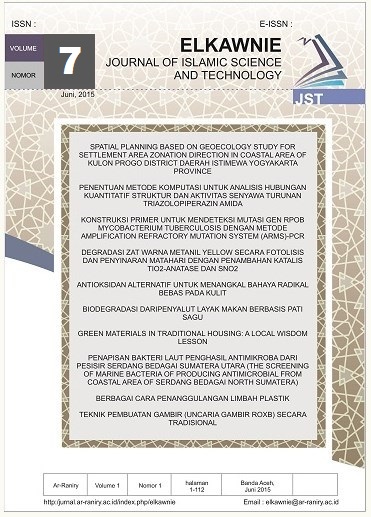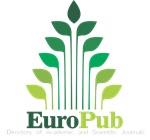Synthesis and Characterization of Bagasse (Saccharumofficinarum L.) Silica Gel Modified Diphenylcarbazone
DOI:
https://doi.org/10.22373/ekw.v7i1.9239Keywords:
Bagasse, Silica Gel, Diphenylcarbazone.Abstract
Abstract: Bagasse is a solid waste from the sugar cane milling process in the sugar industry. The waste can be used as an ingredient in making silica gel which functions as an adsorbent. This can be done by changing its chemical structure composition to increase its role and function. This study aims to determine the characteristics of silica gel synthesized from bagasse (Saccharumofficinarum L.) and modified using diphenylcarbazone as much as 0.24 g with sol-gel technique. The characterization results obtained from Fourier transform infrared (FTIR) analysis of diphenylcarbazone modified silica gel, namely the absorption of Si-OH, Si-O-Si groups supported by the appearance of C꞊O, C꞊N, NH, and N꞊N groups. Characterization using x-ray diffraction (XRD) showed a change in amorphous silica to crystals, with the results obtained showing a crystal size of 41.468 nm.
Abstrak: Ampas tebu merupakan limbah padat yang berasal dari proses penggilingan tebu pada produksi gula. Limbah tersebut dapat dimanfaatkan sebagai bahan pembuatan silika gel yang berfungsi sebagai adsorben. Hal tersebut dapat dilakukan dengan mengubah komposisi struktur kimianya agar dapat meningkatkan peran dan fungsinya. Penelitian ini bertujuan untuk mengetahui karakteristik silika gel yang disintesis dari ampas tebu (Saccharumofficinarum L.) dan dimodifikasi menggunakan difenilkarbazon sebanyak 0,24 gr dengan teknik sol-gel. Diperoleh hasil karakterisasi dari analisis fourier transform infrared (FTIR) terhadap silika gel termodifikasi difenilkarbazon menunjukkan adanya serapan gugus Si-OH, Si-O-Si yang didukung dengan pembentukan gugus C꞊O, C꞊N, N-H, dan N꞊N. Karakterisasi menggunakan difraksi sinar-x (XRD) menunjukkan perubahan silika amorf menjadi kristal dengan hasil yang diperoleh memperlihatkan ukuran kristal sebesar 41,468 nm.
References
Alves, R. ., Reis, T. V. ., Rovani, S., & Fungaro, D. . (2017). Green Synthesis and Characterization of Biosilica Produced from Sugarcane Waste Ash. Hindawi Journal of Chemistry, 2017.
Amri, S., Pranjoto, M., & Si, M. (2017). Preparasi dan Karakterisasi Komposit ZnO-Zeolit untuk Fotodegradasi Zat Warna Congo Red. Jurnal Kimia Dasar, 6(2), 29–36.
Apriawan, D. ., Irham, & Mulyo, J. . (2015). Analisis Produksi Tebu Dan Gula Di Pt. Perkebunan Nusantara Vii (Persero). Agro Ekonomi, 26(2).
Astuti, M. D., Nurmasari, R., & Mujiyanti, D. R. (2012). Immobilization of Silica Gel onto 1-8-dihydroxyanthraquinone Through Sol-Gel Process. Sains Dan Terapan Kimia, 25–34.
Banaei, A., Samadi, S., Karimi, S., Vojoudi, H., Pourbasheera, E., & Badiei, A. (2017). Synthesis of silica gel modified with 2,2′-(hexane-1,6-diylbis(oxy)) dibenzaldehyde as a new adsorbent for the removal of Reactive Yellow 84 and Reactive Blue 19 dyes from aqueous solutions: Equilibrium and thermodynamic studies. Powder Technology, 319, 60–70. https://doi.org/10.1016/j.powtec.2017.06.044
Buhani, & Suharso. (2010). Modifikasi silika dengan 3-aminopropiltrimetoksisilan melalui proses sol gel untuk adsorpsi ion Cd(II) dari larutan. J.Sains MIPA, 16(3), 177–183.
Carrera-Figueiras, C Pérez-Padilla, Yamile Estrella-Gutiérrez, Manuel Alejandro Uc-Cayetano, Erbin G. Avila-Ortega Juárez-Moreno, J. A., & Alejandro. (2019). Surface Science Engineering through Sol-Gel Process. Applied Surface Science. https://doi.org/10.5772/intechopen.83676
Channoy, C., Maneewan, S., Punlek, C., & Chirarattananon, S. (2018). Preparation and Characterization of Silica Gel from Baggase Ash. Advance Material Research, 1145, 44–48.
Chindaprasirt, P., & Rattanasak, U. (2020). Eco-production of silica from sugarcane bagasse ash for use as a photochromic pigment filler. Scientific Reports, 10(1), 1–8. https://doi.org/10.1038/s41598-020-66885-y
Huang, W., Xu, J., Tang, B., Wang, L. H., Tan, X., & Aihua. (2018). Adsorption performance of hydrophobically modified silica gel for the vapors of n-hexane and water. Adsorption Science & Technology, 36, 3–4. https://doi.org/10.1177/0263617417728835
Iqbal, M., Elwina, & Yusrini, M. (2016). Pemanfaatan Limbah Ampas Tebu dalam Pembuatan Silika Gel. Jurnal Sains Dan Teknologi Reaksi, 14.
Kenneth, C. (2015). Review of Spectrometric Identification of Organic Compounds. J. Chem. Educ., 92(10), 1602–1603. https://doi.org/10.1021/acs.jchemed.5b00571
Mujiyanti, D. R., Nuryono, & Kunarti, E. S. (2010). Sintesis Dan Karakterisasi Silika Gel Dari Abu Sekam Padi Yang Diimobilisasi Dengan 3-(Trimetoksisilil)-1-Propantiol. Sains Dan Terapan Kimia, 4(2), 150–167. http://library1.nida.ac.th/termpaper6/sd/2554/19755.pdf
Mupa, M., Hungwe, C. B., Witzleben, S., Mahamadi, C., & Muchanyereyi, N. (2015). Extraction of silica gel from Sorghum bicolour (L.) Moench bagasse ash. African Journal of Pure and Applied Chemistry, 9(2), 12–17. https://doi.org/10.5897/ajpac2015.0603
Nopianingsih, N., Sudiarta, I., & Sulihingtyas, W. (2015). Sintesis Silika Gel Terimobilisasi Difenilkarbazon Dari Abu Sekam Padi Melalui Teknik Sol Gel. Jurnal Kimia, 9(2), 226–234.
Norsuraya, S., Fazlena, H., & Norhasyimia, R. (2016). Sugarcane Bagasse as a Renewable Source of Silica to Synthesize Santa Barbara Amorphous-15 (SBA-15). Procedia Engineering, 148(2016), 839 – 846.
Purwanto, A., Yusmaniar, Ferdiani, F., & Damayanti, R. (2017). Synthesis and adsorption of silica gel modified 3-aminopropyltriethoxysilane (APTS) from corn cobs against Cu(II) in water. International Conference on Chemistry, Chemical Process and Engineering (IC3PE). https://doi.org/10.1063/1.4978105
Rahman, N.A Widiyastuti, W., Sigit, D., Ajiza, M., & Sujana, W. (2017). The Effect of Various Acids on the Gelation Process to the Silica Gel Characteristic Using Organic Silica. International Conference on Chemistry and Material Science.
Serena, E. (2019). “Traditional” Sol-Gel Chemistry as a Powerful Tool for the Preparation of Supported Metal and Metal Oxide Catalysts. Materials, 12(668).
Sheth, K. (2017). Top Sugarcane Producing Countries. worldatlas.com
Sholeh, M., Rochmadi, R., Sulistyo, H., & Budhijanto, B. (2020). Synthesis of precipitated silica from bagasse ash as reinforcing filler in rubber. Mater. Sci. Eng.
Silverstein, R. M., Webster, F. X., & Kiemle, D. J. (2005). Silverstein - Spectrometric Identification of Organic Compounds 7th ed (7th ed.). John Wiley & Sons.
Sjamsiah, Ramadani, K., & Hermawan. (2017). Sintesis Membran Silika Kitosan dari Abu Ampas Tebu (Bagasse). Alkimia, 5(1).
Sudiarta, I., Diantariani, N., & Suarya, P. (2013). Modifikasi Silika Gel Dari Abu Sekam Padi Dengan Ligan Difenilkarbazon. Jurnal Kimia, 7(1), 57–63.
Downloads
Published
Issue
Section
License
Proposed Policy for Journals That Offer Open Access Authors who publish with the Elkawnie journal agree to the following terms:
a. Authors retain copyright and grant the journal right of first publication with the work simultaneously licensed under a Creative Commons Attribution License that allows others to share the work with an acknowledgement of the work's authorship and initial publication in this journal.
b. Authors are able to enter into separate, additional contractual arrangements for the non-exclusive distribution of the journal's published version of the work (e.g., post it to an institutional repository or publish it in a book), with an acknowledgement of its initial publication in this journal.
c. Authors are permitted and encouraged to post their work online (e.g., in institutional repositories or on their website) prior to and during the submission process, as it can lead to productive exchanges, as well as earlier and greater citation of published work (see The Effect of Open Access).

























